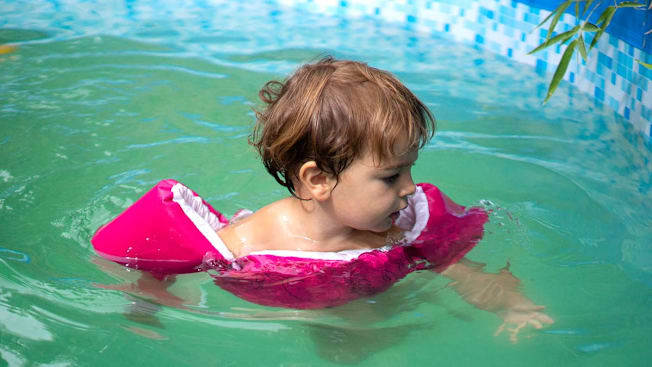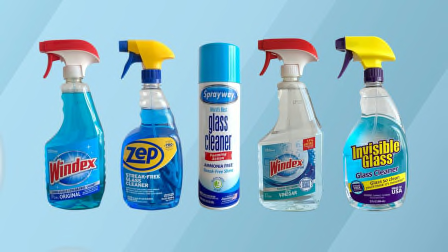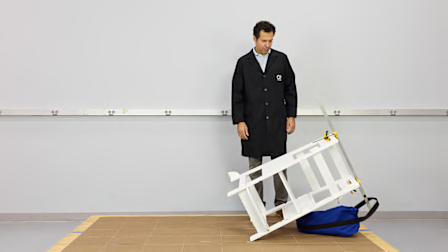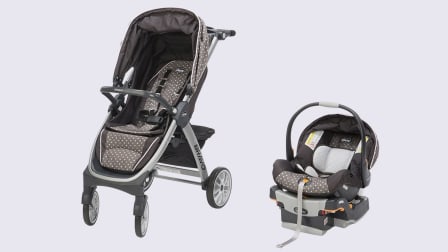Are Puddle Jumpers and Swim Floaties Safe for Kids?
In part one of our Is It Safe? series, experts warn that these popular flotation devices may give kids and parents a false sense of water confidence

"Is it safe?" is a commonly searched phrase among parents, and for good reason. Parents want to know what products are safe to use with their children, and what to avoid. This article is the first in a series about popular products for children and what safety experts want parents to know about them, addressing the question: "Is it safe?"
Puddle Jumpers, a type of brightly colored swim “floatie” for toddlers and young kids, have become mainstays at pools and beaches. These personal flotation devices for young children are popular for their simplicity: The one-piece foam design is easy to put on a squirmy toddler, and lightweight enough to stash in a beach bag. While “Puddle Jumpers” is the original brand name, similar products exist, like the Speedo Swim Star, along with numerous variations sold at retailers like Amazon, Walmart, sporting goods stores, and others.
“Floaties” like Puddle Jumpers may be widely used by parents hoping for extra peace of mind at the pool or by the shore—but safety experts warn that they can give kids a false sense of confidence around water, and may even contribute to drowning.
5 Safety Concerns With Puddle Jumpers and Floaties
1. They’re Often Misused
Puddle Jumpers are marketed as a way to "build water confidence" among kids, and similar floaties are often described as a “swim aid.” But parents should know that these products are not specifically designed to help children learn to swim. “PFDs [personal flotation devices] for children with connected arm and chest flotation components are designed to be buoyancy aids, helping children stay afloat and maintain an upright position in the water,” says Pat Fumagalli, chairman and CSO of Bestway, which licenses the Puddle Jumpers trademark from Coleman. “They are not a substitute for proper swimming instruction for children, and they are intended exclusively for use during supervised water play.”
Fumagalli says that they should not be used for unsupervised water play or in situations requiring long-term flotation or survival.
“The Puddle Jumper label currently has a buoyancy level of 70 [out of 150 for general use], which defines the device as one that is designed for calm and sheltered waters,” says Magrum, such as in the pool, for a short period of time, while being closely and constantly supervised by a capable and undistracted adult. She adds that children should also spend time in the pool, closely supervised but without a flotation device, so that they can understand what their bodies can and can’t do in the water.
While brand-name Puddle Jumpers are a U.S. Coast Guard-approved PFD, there are safer choices with a higher level of buoyancy if you’re around open water, such as on a dock or a boat. “We believe that children should always be wearing a U.S. Coast Guard-approved life jacket with an appropriate buoyancy level and the ability to turn a person face-up whenever in or around open water, on boats, and on docks,” says Magrum, adding that the same recommendation applies for adults.
2. They May Give Children a False Sense of Confidence Around Water
When a child is wearing a Puddle Jumper in the pool, it can give them a sense of security in the water, contributing to overconfidence in their ability to float and swim. The issue is that if a child returns to the water without their Puddle Jumper, they won’t have the skills necessary to keep themselves safe.
“If the child somehow makes their way to or falls into water without the Puddle Jumper during a non-swim time, they may not understand that they will not float as they are now not wearing the flotation device,” says Magrum. Puddle Jumpers are lightweight, and a child may forget they’re wearing one—or worse, forget that they’re not wearing one when they enter the water again.
“PFDs for children with connected arm and chest flotation components are buoyancy aids, and they are not a substitute for swimming lessons or vigilant adult supervision,” says Fumagalli. “Education around correct usage and limitations is essential.” They should always be used in accordance with product warnings and instructions, he says.
3. They May Give Parents a False Sense of Confidence Around Water
Similarly, Puddle Jumpers and similar “floaties” can give parents a false sense of safety, too, which can make parents less vigilant while supervising children around water, says Mona Amin, DO, board-certified pediatrician and founder of PedsDocTalk. “No flotation device or aid (including life vests) is a substitution for supervision,” she says.
Ideally, a parent will remain within arm’s reach and supervise their child with constant, close, undistracted vigilance around water, says Magrum. “Parents often think that if their child is in a flotation device, they’re safe,” she says. But it’s not helping them learn those vital swimming and floating skills. The best way to help kids feel safe and confident in water is through swim education, and to still keep a close eye on them through careful supervision during any water play.
With the right supervision, Puddle Jumpers can solve a pain point for parents. “For my family of four, the Puddle Jumper PFD has been a fun way to get everyone involved in pool time, including our 2-year-old,” says Jamison Hermann, a social media producer at CR. “I’m always in the pool with the kids, so I can pay close attention and give them a hand if they need help. I like that the Puddle Jumper is Coast Guard certified—and, in fact, the pools in our town only allow USCG-approved flotation aids. When my 2-year-old is a little older, we’ll start swimming lessons with no PFD, but for now it’s a helpful tool.”
4. They Keep Kids Vertical in the Water Instead of Horizontal
The primary issue, both Magrum and Amin say, is that Puddle Jumpers and similar products keep kids in a vertical or upright position while in the water, which is what’s considered the drowning position. Lifesaving floating and swimming skills require the body to be horizontal—but Puddle Jumpers and similar floaties don’t easily allow for kids to maneuver into that position.
“Swim experts can tell when a child is used to wearing Puddle Jumpers because they have a harder time training them to float,” says Amin. “This is because their muscle memory is used to being vertical in the water.” Because of that ingrained muscle memory, reliance on Puddle Jumpers could contribute to delayed swimming skill development.
“I think of this like a walker: A baby walker doesn’t teach your child how to walk. It gives them a false sense of security. Practice will teach your child to walk just as practice will teach your child to swim,” says Amin.
Even just increasing the time your kids spend in supervised water play without floaties on can be helpful in establishing effective muscle memory for swimming skills. Nicole Sarrubbo, senior manager of content impact and outreach at CR and mom of two, says she uses floaties with her kids during pool time, but is moving away from using them “because I want my kiddos to learn to swim and float on their own. I didn’t realize that the floaties teach kids to stay upright instead of on their backs," she says.
5. They’re Not a Substitute for Swimming Lessons
Swim lessons can teach kids to float on their backs in order to keep their heads and airways out of the water, as well as how to swim; both are lifesaving skills. The American Academy of Pediatrics (AAP) recommends starting swim lessons as early as 1 year of age. Amin says she highly encourages her patients to start swim lessons at least by 15 months to create the repetition and practice of skills early on. Amin says her own son cried through his first two weeks of swimming lessons, “but now he loves it.”
After swim lessons have started, don’t be tempted to put kids back into Puddle Jumpers for water play, as it can undo the new skills they’ve gained, the NDPA says. Do use a life jacket any time you’re going to be around open water, however. “Once children are able to float on their own, they should wear a properly fitted U.S Coast Guard flotation device on a dock, a boat, or around or in open water like lakes, oceans, and rivers,” says Magrum.
How to Keep Kids Safe in and Around the Water
Swimming lessons are a great way to foster water confidence. But lessons can be both cost- and time-prohibitive for many families, says Amin. “In a dream world, they would be easily accessible and built into a child’s routine.” That’s not always the case for many families, though there are services that offer free or reduced-price swim lessons to teach more kids the life-saving skills they need.
Check with local pools, the YMCA, the American Red Cross, and your area’s parks and recreation department to see what’s on offer. Some may have free or reduced-cost swimming lessons available—and it’s worth calling even before your child’s first birthday in case there’s a waitlist. As another resource, Water Safety USA has a thorough outline on what to look for in a learn-to-swim program. And if you haven’t yet learned to swim, or could use a brush-up on your skills? “It’s never too late,” says Magrum.
But swimming lessons still don’t make kids “drown-proof,” the AAP says. Parents and caregivers should employ multiple layers of protection to keep kids safe around water. The concept is similar to what’s known as the Swiss Cheese model. Each layer might have holes, but when stacked up, more gaps are covered.
The NDPA recommends the following five layers for water safety:
- Barriers and alarms around pools, such as high fencing with self-latching gates and pool safety covers.
- Constant supervision from a close, capable adult. Be sure to designate a “water watcher” for every swim session, who can be alert, undistracted, and on-hand to monitor water play. If you can, regularly rotate water-watching sessions with another trusted adult every 15 minutes. The American Red Cross has a free downloadable Water Watcher card to help the designated adult be visible.
- Water competency skills: Basic water safety skills, like floating, can reduce the risk of drowning.
- USCG-approved life jackets, especially around open water.
- Emergency preparedness, including knowing CPR and basic water rescue skills, and having a phone nearby to call 911 if there’s an emergency.
At the pool and at home, work to build up your child’s water skills and confidence through repeated exposure to supervised water play without relying on a flotation device. Magrum recommends introducing infants to water via supervised bathtime. This builds a healthy relationship with water, and helps them learn to get their faces wet. For example, a parent or caregiver can use a cup to pour water over the baby’s head after a countdown cue (“3, 2, 1!”), which can help them be more comfortable when learning to swim later, she says. For older children, have regular conversations about water safety. Teach them not to go near water without adult permission, emphasizing that water, while fun, demands respect due to its dangers.




















